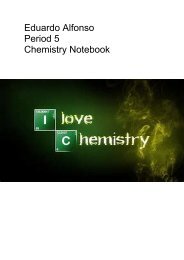You also want an ePaper? Increase the reach of your titles
YUMPU automatically turns print PDFs into web optimized ePapers that Google loves.
130<br />
The Learning Goal for this assignment is: Students will learn how the interactions between<br />
water molecules account for the unique properties of water and how the aqueous solutions form.<br />
Take note over the following chapter. Use the Headings provided to organize your notes. Define and number all highlighted vocabulary (total 22 ) as well<br />
as summarize and take notes over the sections. You may add pictures where needed. The pictures should be an appropriate size. Use Arial 12 for all<br />
text. This document should be 2 pages and should be saved as a pdf before you submit it into Angel.<br />
Chapter 15 Water and Aqueous Systems<br />
Pages 488 - 507<br />
15.1 Water and Its Properties<br />
Water in the Liquid State-<br />
Without water life would not be possible. The oxygen atoms within the water form a covalent bond<br />
with the atoms of hydrogen. The bond between O-H is highly polar. Dipole interactions attract polar<br />
molecules to one another. Covalent bonds are known to be stronger than hydrogen bonds. Despite<br />
the previous statement, they are stronger than other intermolecular forces. Water has an inward force<br />
or pull that tends to minimize the surface area of a liquid, this is called surface tension 1 . The surface<br />
of water acts like a skin. Surface tension is reduced by a surfactant 2 which is any substance that<br />
interferes with hydrogen bonding in water molecules<br />
Water in the Solid State<br />
Water in its solid state has less density than water in its liquid state. It is important for certain<br />
organisms that ice floats, because a layer of ice on top of the water acts as an insulator for the water<br />
beneath which stops the water from freezing solid with the exception of extreme conditions<br />
15.2 Homogeneous Aqueous Systems<br />
Solutions<br />
Because of the vast amount of substances that water dissolves when they come in contact with it<br />
you will never find water that is chemically pure in nature. All water contains dissolved substances,<br />
and this is called an aqueous solution 3 . Within an aqueous solution the medium in which the water is<br />
dissolved is refered to as a solvent 4 and the particles being dissolved are called a solute 5. All solutions<br />
are homogenous mixtures. The average diameter of solute particles, which can consist of atoms ions<br />
or molecules is ussually less than 1 nm. For this reason you can’t separate a solution through filter<br />
paper as both the solvent and solute would pass through. Nonpolar covalent compounds do not<br />
dissolve in water. In the process called solvation 6 , the positive and negative ions of an ionic solid<br />
become surrounded by solvent molecules.<br />
Electrolytes and Nonelectrolytes<br />
An electrolyte 7 is a compound that conducts an electric current when it is an aqueous solution or in<br />
the molten state. In order for an electric current to conduct it needs ions that are mobile, as they are<br />
capable of carrying electrical currents through a liquid. Some ionic compounds cannot conduct an<br />
electric current in an aqueous solution because they are insoluble, however despite this it does have<br />
the ability to conduct in a molten state. Compounds that can’t conduct in either states (aqueous or<br />
molten) are called nonelectrolytes 8 . In a solution that contains a strong electrolyte 9 all or almost all of<br />
the solute exists of ions. In a solution with a weak electrolyte 10 , only a fraction of the solute exists as<br />
ions and therefore it conducts poorly. Electrolytes are essential to all metabolic processes.



